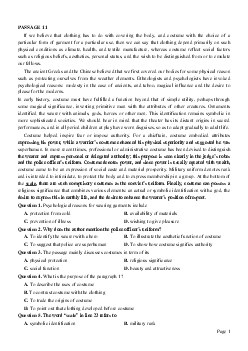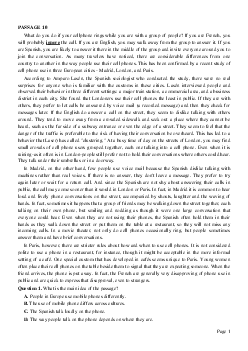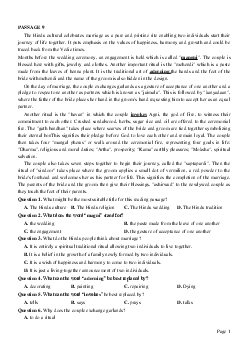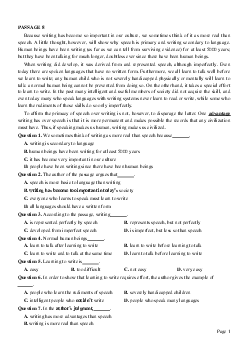


Preview text:
PASSAGE 26
Pollution is the degradation of natural environment by external substances introduced directly or
indirectly. Human health, ecosystem quality and aquatic and terrestrial biodiversity may be affected and
altered permanently by pollution.
Pollution occurs when ecosystems cannot get rid of substances introduced into the environment. The
critical threshold of its ability to naturally eliminate substances is compromised and the balance of the ecosystem is broken.
The sources of pollution are numerous. The identification of these different pollutants and their effects
on ecosystems is complex. They can come from natural disasters or the result of human activity, such as
oil spills, chemical spills, nuclear accidents... These can have terrible consequences on people and the
planet where they live: destruction of the biodiversity, increased mortality of the human and animal
species, destruction of natural habitat, damage caused to the quality of soil, water and air...
Preventing pollution and protecting the environment necessitate the application of the principles of
sustainable development. We have to consider satisfying the needs of today without compromising the
ability of future generations to meet their needs. This means that we should remedy existing pollution, but
also anticipate and prevent future pollution sources in order to protect the environment and public health.
Any environmental damage must be punishable by law and polluters should pay compensation for the
damage caused to the environment.
Question 1. What is the topic of the passage?
A. Pollution: causes, effects and solutions.
B. Pollution - a big problem. C. What is pollution?
D. What should we do to protect environment?
Question 2. The phrase "get rid of" in paragraph 2 is closest meaning to: A. remove B. replace C. reuse D. recycle
Question 3. According to the passage, these are sources of pollution, EXCEPT A. natural disasters B. oil spills C. killing animals D. nuclear accidents
Question 4. Which sentence is TRUE?
A. Human race is the only species affected by pollution.
B. It is not easy to identify the pollutants and their effects on ecosystem.
C. Pollution is harmless to natural habitat.
D. Human activity doesn't cause pollution.
Question 5. The pronoun “they" in paragraph 3 refers to A. natural disasters B. people C. consequences D. nuclear accidents
Question 6. According to the passage, what should be done to protect the environment?
A. We should try our best to meet our needs of today.
B. We should not care for the existing pollution.
C. People who damage the environment should be rewarded.
D. People should be made to pay compensation if they damage the environment.
Question 7. It can be inferred from the last paragraph that
A. We cannot prevent the sources that may cause pollution in the future.
B. Future generations may not meet their needs because of pollution we cause today. Page 1
C. We can do nothing to remedy pollution.
D. Biodiversity will not be influenced if animals are killed. ĐÁP ÁN 1-A 2-A 3-C 4-B 5-B 6-D 7-B 8- 9- 10
LỜI GIẢI CHI TIẾT Question 1: A
Chủ đề của đoạn văn là gì?
A. Ô nhiễm: nguyên nhân, ảnh hưởng và giải pháp.
B. Ô nhiễm - một vấn đề lớn. C. Ô nhiễm là gì ?.
D. Chúng ta nên làm gì để bảo vệ môi trường?
=> Dẫn chứng: Pollution is the degradation of natural environment by external substances introduced
directly or indirectly. Human health, ecosystem quality and aquatic and terrestrial biodiversity may be
affected and altered permanently by pollution.
Pollution occurs when ecosystems cannot get rid of substances introduced into the environment.
Preventing pollution and protecting the environment necessitate the application of the principles of sustainable development.
Dịch: Ô nhiễm là sự xuống cấp của môi trường tự nhiên bởi các chất bên ngoài được giới thiệu trực tiếp
hoặc gián tiếp. Sức khỏe con người, chất lượng hệ sinh thái và đa dạng sinh học dưới nước và trên cạn có
thể bị ảnh hưởng và thay đổi vĩnh viễn do ô nhiễm.
Ô nhiễm xảy ra khi hệ sinh thái không thể loại bỏ các chất được đưa vào môi trường.
Ngăn chặn ô nhiễm và bảo vệ môi trường đòi hỏi phải áp dụng các nguyên tắc phát triển bền vững. Question 2: A
Cụm từ "bỏ" trong đoạn 2 có nghĩa gần nhất với: A. loại bỏ B. thay thế C. tái sử dụng D. tái chế => Đáp án A Question 3: C
Theo đoạn văn, đây là những nguồn gây ô nhiễm, NGOẠI TRỪ
A. thiên tai B. sự cố tràn dầu
C. giết động vật D. tai nạn hạt nhân
=> Dẫn chứng: They can come from natural disasters or the result of human activity, such as oil spills,
chemical spills, nuclear accidents...
Dịch: Chúng có thể đến từ các thảm họa tự nhiên hoặc kết quả của hoạt động của con người, như sự cố
tràn dầu, sự cố tràn hóa chất, tai nạn hạt nhân ... Question 4: B Câu nào là đúng ?
A. Loài người là loài duy nhất bị ảnh hưởng bởi ô nhiễm. Page 2
B. Không dễ để xác định các chất ô nhiễm và ảnh hưởng của chúng đối với hệ sinh thái.
C. Ô nhiễm là vô hại đối với môi trường sống tự nhiên.
D. Hoạt động của con người không gây ô nhiễm.
=> Dẫn chứng: The identification of these different pollutants and their effects on ecosystems is complex.
Dịch: Việc xác định các chất ô nhiễm khác nhau này và ảnh hưởng của chúng đối với các hệ sinh thái là phức tạp Question 5: B
Đại từ “they "trong đoạn 3 đề cập đến A. thiên tai B. con người
C. hậu quả D. tai nạn hạt nhân
=> Dẫn chứng: These can have terrible consequences on people and the planet where they live:
destruction of the biodiversity, increased mortality of the human and animal species, destruction of
natural habitat, damage caused to the quality of soil, water and air...
Dich: Những điều này có thể gây ra hậu quả khủng khiếp đối với con người và hành tinh nơi họ sinh
sống: phá hủy đa dạng sinh học, tăng tỷ lệ tử vong của loài người và động vật, hủy hoại môi trường sống
tự nhiên, thiệt hại gây ra cho chất lượng đất, nước và không khí ... Question 6: D
Theo đoạn văn, cần làm gì để bảo vệ môi trường?
A. Chúng ta nên cố gắng hết sức để đáp ứng nhu cầu của chúng ta ngày hôm nay.
B. Chúng ta không nên quan tâm đến ô nhiễm hiện có
C. Những người làm hỏng môi trường nên được khen thưởng.
D. Mọi người nên được thực hiện để bồi thường nếu họ làm hỏng môi trường.
=> Dẫn chứng: Any environmental damage must be punishable by law and polluters should pay
compensation for the damage caused to the environment.
Dịch: Bất kỳ thiệt hại môi trường phải bị trừng phạt theo pháp luật và người gây ô nhiễm phải bồi thường
thiệt hại cho môi trường. Question 7: B
Có thể suy ra từ đoạn cuối
A. Chúng tôi không thể ngăn chặn các nguồn có thể gây ô nhiễm trong tương lai.
B. Các thế hệ tương lai có thể không đáp ứng nhu cầu của họ vì ô nhiễm mà chúng ta gây ra ngày nay.
C. Chúng ta không thể làm gì để khắc phục ô nhiễm.
D. Đa dạng sinh học sẽ không bị ảnh hưởng nếu động vật bị giết
=> Dẫn chứng: This means that we should remedy existing pollution, but also anticipate and prevent
future pollution sources in order to protect the environment and public health.
Dịch: Điều này có nghĩa là chúng ta nên khắc phục ô nhiễm hiện có, nhưng cũng dự đoán và ngăn chặn
các nguồn ô nhiễm trong tương lai để bảo vệ môi trường và sức khỏe cộng đồng. Page 3




